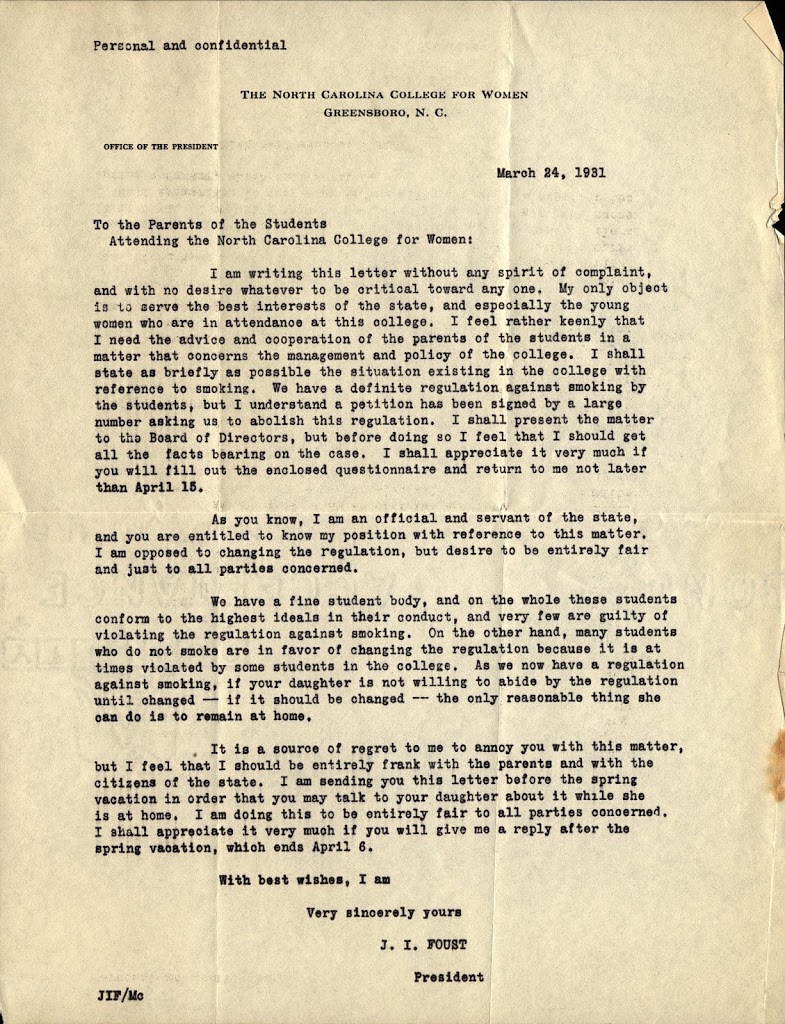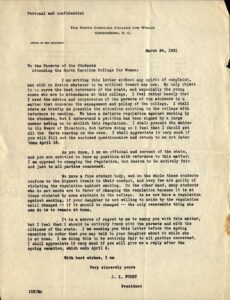The history of tobacco in the United States is synonymous with the history of North Carolina. North Carolina’s tobacco ventures date to the early 16th century, with the arrival of the first English settlers and the crop has long played a key role in the development of the state’s business and agriculture heritage. Major tobacco manufactures, such as R.J. Reynolds and James Duke, had presence in the state directly following the Civil War. Despite these strong ties, when the State Normal and Industrial College (now UNCG) for women opened in 1892, its founder Charles McIver, expressly forbade smoking by the students on campus.
While smoking was formally prohibited, this did not stop the students from occasionally risking punishment for the chance to smoke a cigarette. In 1897, a “smoking indecent” occurred during which over 30 students were caught smoking by administrators. As a consequence of their actions, they were required to write individual confession letters admitting their guilt and identifying if they knew other students who had smoked. It is unclear what, if any, formal reprimand was given for such a breach of college rules.
The prohibition of smoking on campus would continue until the fall of 1931, when Chancellor Julius Foust was presented a signed petition from 1032 students requesting that the policy be amended. At that time, over 1/3 of judicial “student conduct write-ups” were for violating smoking regulations.
Recognizing the futility of continuing to ban smoking, Foust, under the authorization given to him by the Board of Directors, reached a compromise for the girls to smoke the rest of the academic year (January to May 1932); however, they were only allowed to smoke in their dorm rooms following specific regulations. Foust was reluctant to condone such behavior, believing it to be unhealthy and that “any student who becomes addicted to the habit of smoking to excess will, in after years, regret it.”
Over the next decades, campus policies on smoking periodically shifted, reflecting the current social climate. During the 1950s and 1960s, smoking was permitted in designated areas in various buildings, and for a trial period, in large seminar classrooms at the professor’s discretion. By the 1970s, there was some student push back on the policies. They wanted a ban on smoking in classrooms, noting its bothersome nature and negative health effects. However, it would not be until the late 1980s and early 1990s, with the launch of a public national campaign highlighting the harmful effects of tobacco, that a serious movement would occur to curb smoking at UNCG.
In June 1990, following the recommendations put forth by the Health Promotion Committee, a new smoking policy was implemented across the campus. It established a Smoking Regulation Committee, which was charged with reviewing and recommending which buildings would prohibit smoking. Some faculty members were disappointed that Chancellor William Moran did not issue a smoking ban across the entire campus and questioned if UNCG’s heavy financial ties to local tobacco companies, such Lorillard and R.J. Reynolds, had a factor in his reluctant stance
In March 1991, nine campus buildings were designated as “smoke-free,” including the Bryan, Curry, and McIver buildings, and by December, this number would grow to a total of sixteen. The University would eventually forbid smoking in all buildings, including residence halls. Finally, in August 2008, a new outdoor smoking policy was adopted that prohibited smoking within twenty-five feet of any campus building. Today, UNCG remains committed to helping curb tobacco use by students and faculty though their support of cession programs and services.
By Sean Mulligan

